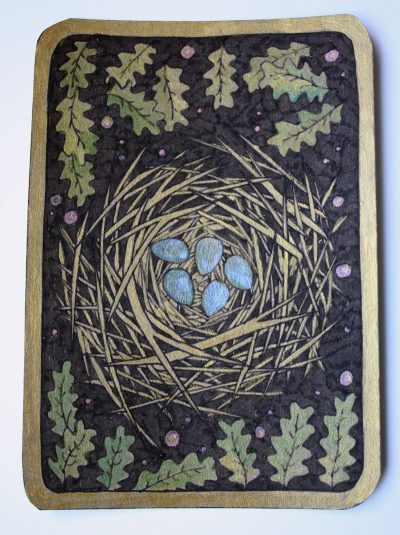
I could tell you about how grim the start of my year was and how, after one thing and then another, I caught Covid and am now recovering. Covid wasn’t so bad, but…enough about that. I’ll tell you instead about the Nest Project that I’ve been working on.
It’s time for nests. I’ve been watching a blackbird looking for suitable nesting sites in the garden and I’ve seen a crow diligently prising off twigs from one of our elder bushes for a nest in a tall tree a few doors down. I love finding nests from previous seasons, their intricacy intrigues me.
I recently went to an exhibition called Undercurrents by Louise McCurdy and Steve Geliot. It was about the starlings on the Palace Pier and their murmurations. Here is a photo from the exhibition of a giant starling’s nest. I love the interwoven flowers.

Apparently flowers and bark have aromatic chemicals so if woven into a nest they can fumigate it and deter parasites.
I’ve got out of the library, Nests by Susan Ogilvy. The book is gorgeous with lovely pink/cream pages and her watercolour paintings are exquisite. Here is one of her wren’s nests made of fine twigs, grasses, moss, skeleton leaves, feathers and hair:

And here is a photo of a wren’s nest I found in the garden last year, deep in the ivy (photographed after the wrens had fledged and left). You can see that the materials are very similar:
Below is my feeble attempt at painting an old mud-lined song thrushes’ nest as a still life:

I’ve been working on my Altered Sketchbook and have added the next section, section 2, a nest in the undergrowth. I’ve based it on a willow warbler’s nest, which is typically domed and made close to the ground. I’ve made a short video showing the whole of the altered sketchbook so far, including the nest section:
Here are some images of the Nest section (click on the images to see larger versions):
I’ve started working on a Nest nature booklet/zine. So far I’ve drawn blackbirds at their nest in the undergrowth:

In Wolstonbury Woods, just outside Brighton, there’s a large circle of sticks in the shape of a beautiful, human-sized nest:

Who made the nest I had no idea, until I did a bit of research and discovered the website of artist Flick Ferdinando. You can see more photos of the nest and a film about it on her website.
I’ve collected together images of some of the nests I’ve found over the years – a lesser black-backed gulls’ nest; a dormouse’s summer nest; an unknown nest with woodpigeon and blackbird eggshells; a long-tailed tits’ nest; a blackbird’s nest(?) in a hornbeam; a wren’s nest. Each one has a story, told very briefly below each image.

























